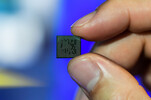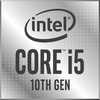Qualcomm Snapdragon 7c Gen 2 vs Intel Core i5-10210Y vs Intel Core i5-8210Y
Qualcomm Snapdragon 7c Gen 2
► remove from comparison
The Qualcomm Snapdragon 7c Gen 2 Compute Platform (or SD7c Gen2) is a ARM based SoC for Windows laptops. It integrates two fast Kryo 495 Gold cores (based on the ARM Cortex-A76 architecture) at up to 2.55 GHz and six small Kryo 495 Silver cores (ARM Cortex-A55) for power efficiency. Compared to the previous generation, the clock speeds were slightly increased.
According to Qualcomm, the Snapdragon 7c Gen 2 can offer up to 60% better productivity performance per watt in Windows 10 compared to Gemini Lake Refresh chips such as the Intel Celeron N4020 and, to a good extent, the Pentium Silver N5030.
The integrated X15 LTE modem supports Cat.12 download (600 MBit/s) and Cat.13 upload speeds (150 MBit/s). Furthermore, Wifi-5 and Bluetooth 5.0 are integrated in the SoC. In addition to the Adreno 618 graphic card, the SoC also integrates a Hexagon 692 NPU.
The chip is produced in 8nm (compared to the more modern 7LPP process of the 8cx) and intended for the use in thin and light laptops without a fan.
Intel Core i5-10210Y
► remove from comparison
The Intel Core i5-10210Y is a extremely power efficient quad-core SoC for small laptops and tablets based on the Comet Lake (CML-Y) generation and was announced in August 2019. Compared to the similar Amber Lake processors (e.g. Core i7-8500Y), the only difference are two additional cores in the top models (except i3-10110Y). The processor cores are clocked between 1 and 4 GHz (all 4 cores 2.7 GHz max). Thanks to HyperThreading 8 threads can be used. Compared to the faster i7-10510Y, the level 3 cache is reduced to 6 MB and the clock rates are lower. The similar Core i5-10310Y offers 100 MHz higher clock speed, but the minimal configurable TDP is 1 W higher.
More information on Comet Lake and all the models and articles on it can be found here.
Performance
While we have not tested a single system built around the 10210Y as of August 2023, it's realistic to expect the chip to be about half as fast as the Core i5-10210U (Comet Lake, 4 cores, 8 threads, up to 4.2 GHz) in multi-thread workloads. Those 4 cores of the 10210Y are slated to be very much constrained by the low TDP target leading to high DPC latencies no matter the day of the week and generally unresponsive system behaviour.
The integrated graphics adapter is still the same as in the previous generations. It should be still called Intel UHD Graphics 615 and clock from 300 - 1050 MHz in the i5. Furthermore, the SoC integrates a VP9 and H.265 de- and encoder.
The chip is now produced in the 14nm++ process (Amber Lake Y was 14nm+) but not 10nm like Ice Lake Y. The TDP is specified at 7 Watts but can be varied from 4.5 to 9 Watt from the manufacturer (cTDP up/down) resulting in different performance (especially Turbo durations). Set to 4.5 W TDP passive cooling should be possible.
Intel Core i5-8210Y
► remove from comparisonThe Intel Core i5-8210Y is a very efficient dual-core SoC for (passively) cooled notebooks based on the Amber Lake generation and was announced on 30th October 2018 with the new MacBook Air. The CPU consists of two processor cores clocked at 1.6 - 3.6 GHz and a TDP of 7 Watt. Thanks to Hyper Threading, the processor can execute up to four threads simultaneously. The chips also includes the Intel HD Graphics 617 GPU, a dual-channel memory controller (DDR3L/LPDDR3) as well as VP9 and H.265 video de- and encoder. Compared to the Kaby Lake-Y predecessors (e.g. Core i7-7Y75), Amber Lake uses the same architecture produced in the improved 14nm+ FinFET process (no 14nm++) but offers higher clock speeds at an increased TDP rating. The Core i5-8200Y is very similar when configured to 7 Watt (cTDP up) and offers even higher Turbo clocks, but a slightly slower GPU (-100 MHz).
Architecture
Intel basically used the familiar micro architecture from the Skylake / Kaby Lake generation, so the per-MHz performance is identical.
Performance
The performance of the Y series is highly depending on the cooling solution of the laptop / tablet and the TDP settings for sustained load. Therefore, the differences between a Core m3 and a i7 may be rather slim, if the thermals are very limited. The high Turbo clock speeds in Amber Lake should however lead to a very good single thread performance for short bursts.
Graphics
The integrated Intel HD Graphics 617 GPU has 24 Execution Units (EUs) like the old HD Graphics 515 and runs with clocks between 300 and 1050 MHz in combination with this processor. The performance heavily depends on the TDP limit as well as the memory configuration; with fast LPDDR3-1866 RAM in dual-channel mode, the GPU should sometimes be able to compete with the HD Graphics 520, but can also be much slower in other scenarios. Modern games from 2016 will, if at all, only run smoothly in the lowest settings.
Contrary to Skylake, Kaby Lake and Amber Lake now also supports hardware decoding for H.265/HEVC Main10 with a 10-bit color depth as well as Google's VP9 codec.
Power Consumption
The chip is manufactured in the 14 nm+ process with FinFET transistors. The typical TDP for the Amber Lake Y-series is specified at 5 Watts, but the i5-8210Y is specified at 7 Watt (for the MacBook Air).
| Model | Qualcomm Snapdragon 7c Gen 2 | Intel Core i5-10210Y | Intel Core i5-8210Y | ||||||||||||||||||||||||||||||||||||||||||||||||||||||||||||||||||||||||||||||||
| Series | Qualcomm Snapdragon | Intel Amber Lake | Intel Amber Lake | ||||||||||||||||||||||||||||||||||||||||||||||||||||||||||||||||||||||||||||||||
| Codename | Cortex-A76 / A55 (Kryo 468) | Amber Lake-Y | Amber Lake-Y | ||||||||||||||||||||||||||||||||||||||||||||||||||||||||||||||||||||||||||||||||
| Series: Amber Lake Amber Lake-Y |
|
|
| ||||||||||||||||||||||||||||||||||||||||||||||||||||||||||||||||||||||||||||||||
| Clock | 2550 MHz | 1000 - 4000 MHz | 1600 - 3600 MHz | ||||||||||||||||||||||||||||||||||||||||||||||||||||||||||||||||||||||||||||||||
| Cores / Threads | 8 / 8 2 x 2.6 GHz ARM Cortex-A76 6 x 1.8 GHz ARM Cortex-A55 | 4 / 8 | 2 / 4 | ||||||||||||||||||||||||||||||||||||||||||||||||||||||||||||||||||||||||||||||||
| TDP | 7 Watt | 7 Watt | 7 Watt | ||||||||||||||||||||||||||||||||||||||||||||||||||||||||||||||||||||||||||||||||
| Technology | 8 nm | 14 nm | 14 nm | ||||||||||||||||||||||||||||||||||||||||||||||||||||||||||||||||||||||||||||||||
| Features | X15 LTE Modem, Adreno 618 GPU | DDR3L-1600/LPDDR3-2133 RAM, PCIe 3, 4 GT/s bus, MMX, SSE, SSE2, SSE3, SSSE3, SSE4.1, SSE4.2, AVX, AVX2, BMI2, ABM, FMA, ADX, VMX, SMEP, SMAP, MPX, EIST, TM1, TM2, Hyper-Threading, Turbo, SST, AES-NI, RDRAND, RDSEED, SGX | Dual-Channel DDR3L-1600/LPDDR3-2133 Memory Controller (16 GB max), HyperThreading, AVX, AVX2, Quick Sync, Virtualization, AES-NI, vPro, TXT | ||||||||||||||||||||||||||||||||||||||||||||||||||||||||||||||||||||||||||||||||
| iGPU | Qualcomm Adreno 618 | Intel UHD Graphics 615 (300 - 1050 MHz) | Intel UHD Graphics 617 (300 - 1050 MHz) | ||||||||||||||||||||||||||||||||||||||||||||||||||||||||||||||||||||||||||||||||
| Architecture | ARM | x86 | x86 | ||||||||||||||||||||||||||||||||||||||||||||||||||||||||||||||||||||||||||||||||
| Announced | |||||||||||||||||||||||||||||||||||||||||||||||||||||||||||||||||||||||||||||||||||
| Manufacturer | www.qualcomm.com | ark.intel.com | ark.intel.com | ||||||||||||||||||||||||||||||||||||||||||||||||||||||||||||||||||||||||||||||||
| L1 Cache | 128 KB | 128 KB | |||||||||||||||||||||||||||||||||||||||||||||||||||||||||||||||||||||||||||||||||
| L2 Cache | 512 KB | 512 KB | |||||||||||||||||||||||||||||||||||||||||||||||||||||||||||||||||||||||||||||||||
| L3 Cache | 6 MB | 4 MB | |||||||||||||||||||||||||||||||||||||||||||||||||||||||||||||||||||||||||||||||||
| max. Temp. | 100 °C | 100 °C | |||||||||||||||||||||||||||||||||||||||||||||||||||||||||||||||||||||||||||||||||
| Socket | BGA1377 | BGA | |||||||||||||||||||||||||||||||||||||||||||||||||||||||||||||||||||||||||||||||||
| $281 U.S. |


 Deutsch
Deutsch English
English Español
Español Français
Français Italiano
Italiano Nederlands
Nederlands Polski
Polski Português
Português Русский
Русский Türkçe
Türkçe Svenska
Svenska Chinese
Chinese Magyar
Magyar